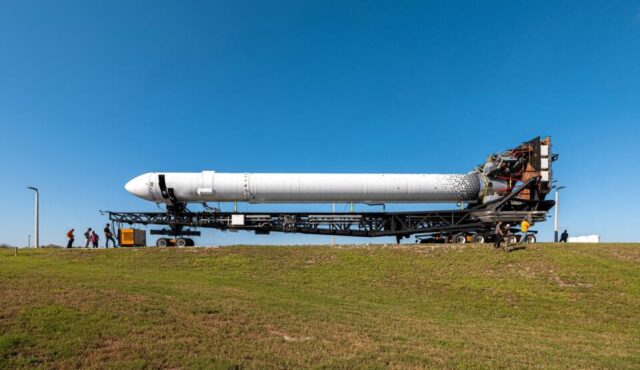A 3D-printed rocket lifted off successfully and survived the perilous moment of maximum dynamic pressure, where speed and the still-thick atmosphere conspire to tear rockets apart.
FOR A failed rocket launch, there sure was a lot of cheering.
When Relativity Space, a California start-up that aims to compete against SpaceX, finally launched its Terran 1 rocket manufactured almost entirely by 3D printing, it achieved so many of the milestones the company had hoped for.
It lifted off successfully from its pad at Cape Canaveral Space Force Station in Florida at 11.25pm (5.25am South African time) on Wednesday.
It survived the perilous moment of maximum dynamic pressure, where speed and the still-thick atmosphere conspire to tear rockets apart.
The first stage separated cleanly from the second stage, as commentators on the company’s broadcast cheered it on. But then the second stage engine failed to ignite, preventing the rocket from making it to orbit.
Still, Relativity proved that its technology could survive at least the initial punishing rigours of space flight, offering a bit of hope amid a bad run for the start-up rocket business. And it vowed to be back at it soon.
From the beginning the company, which was founded seven years ago and backed by more than $1 billion in venture capital investment, had tried to temper expectations, saying that while orbit was the main goal, just getting off the pad would be a success.
The launch was the first of an additive manufactured rocket. Additive manufacturing is more commonly known as 3D printing. About 85% of the 33.5-metre-tall two-stage vehicle was built using a massive 3D printer, which the company says could be used for a number of products and ultimately include manufacturing in space.
The company has argued that 3D printing offers several advantages: It eliminates the need to rely on outside suppliers, uses fewer parts and, as a result, has “radically simplified” the rocket science traditionally required to manufacture launch vehicles.
Given the novel technology and the difficulties with maiden flights, the launch marked a significant achievement, said Greg Autry, the director and clinical professor of policy and business at the Thunderbird School of Global Management at Arizona State University.
“No entirely new rocket gets to space on launch one, and Terran 1 is the most revolutionary launch vehicle in 60 years,” he said before the launch attempt. “If it simply gets off the pad without the 3D-printed cryotanks rupturing, they will have proved the critical tech behind their additive manufacturing approach. Getting to stage separation would be extra points.”
In a tweet, the company said the rocket survived “the highest stress state on our printed structures. This is the biggest proof point for our novel additive manufacturing approach. Today is a huge win, with many historic firsts.”
Relativity has become an example of the growth of an industry once dominated by defence contractors, and, later, billionaires such as Elon Musk and Jeff Bezos, who used their fortunes to fund their space ventures.
Tim Ellis, Relativity’s co-founder and CEO, raised hundreds of millions of dollars from investors and scored one of his first investments from Mark Cuban.
On Twitter, Ellis reflected on the company’s journey, which he and his co-founder started “in a WeWork, truly from scratch, where we had to rally and scrap together every ounce of funding, team, facilities”.
But it comes as a number of space start-ups are facing real challenges. Virgin Orbit, the space start-up founded by Richard Branson, recently paused operations after a rocket failure and is reportedly trying to raise additional capital to keep it going.
Astra, another rocket start-up, is facing being delisted from the Nasdaq composite index after its troubles. And as interest rates rise and investment dries up, many analysts have said a reckoning is coming – or has arrived – for an industry that thrived on big dreams and hype but still has a lot to prove.
Relativity has tried to separate itself from the pack with its novel manufacturing technique. In 2021, Ellis predicted that 3D printing would become “the dominate force, not just in the launch industry, but in aerospace overall, which hasn’t changed for 60 years”.
He said: “We’re still building products one at a time by hand with hundreds of thousands to millions of individual parts, a very complicated supply chain, a ton of manual labour and really inefficient cost structures.”
Relativity, which is based in Long Beach, has rehabilitated one of the old launch sites at Cape Canaveral, one of several that has been brought back to life by new companies. SpaceX has operated out of two pads nearby and has its landing zone next door. Jeff Bezos’s Blue Origin is just down the road. And the Space Force recently announced that three other pads at the Cape would be leased to commercial launch companies, including Stoke Space, which like Relativity was founded by former employees of Blue Origin.
Ellis started there in 2011, where he worked for about five years before deciding to start Relativity. When he went out to raise money in 2016, he pitched nearly 100 investors before one finally said yes, leading to a $10m fund-raising round.
A few years later, it was a different story. The company raised $500m and then another $650m as investors were drawn not just by the rockets Ellis was proposing, but the way in which Relativity would manufacture them.
However, the company needed to show that it would be able to get to orbit. The company says it has a host of customers, including Nasa, waiting for launches on its Terran 1 rocket. It is also developing a larger, more powerful vehicle, the Terran R, which would be fully reusable. The company hopes to launch it next year.
– THE WASHINGTON POST








